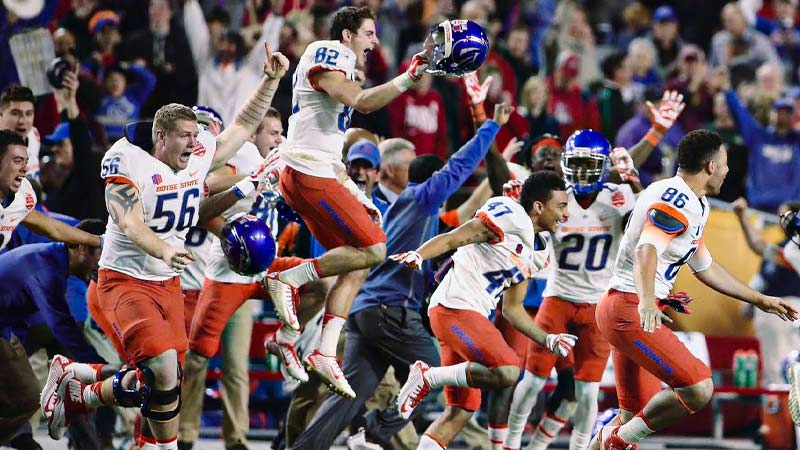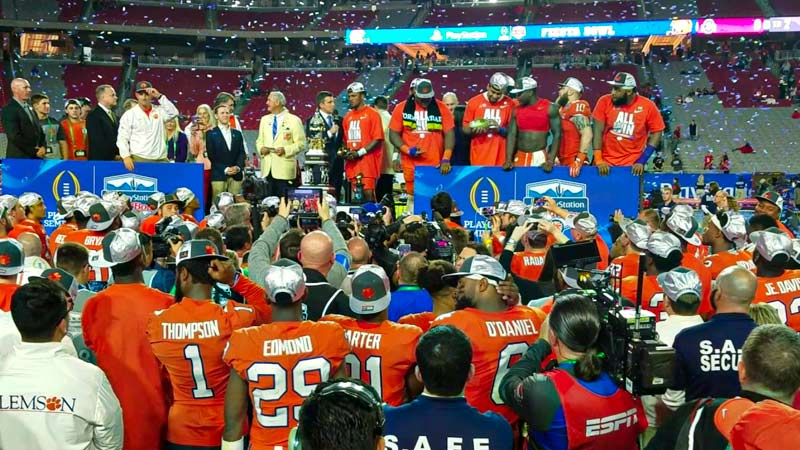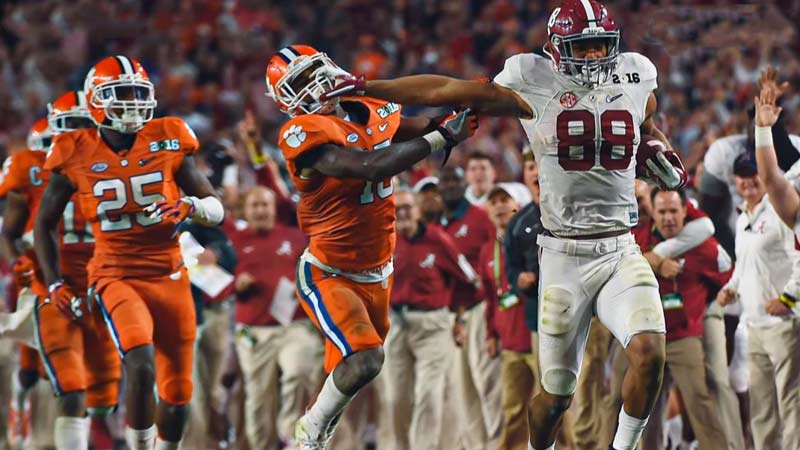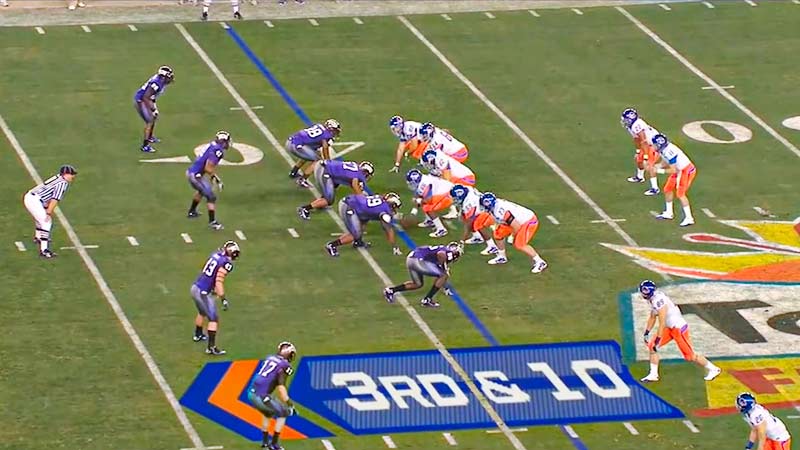The Football Fiesta Bowl stands as a vibrant celebration of gridiron excellence, captivating fans with its thrilling matchups and electrifying atmosphere.
As one of the premier bowl games in college football, the Fiesta Bowl has become a cherished tradition that showcases the sport’s finest talents on a grand stage.
With a rich history dating back to its inception in 1971, this annual spectacle has captivated audiences with its high-stakes showdowns and unforgettable moments.
The Football Fiesta Bowl takes place in Glendale, Arizona, at the magnificent State Farm Stadium, which boasts a seating capacity of over 63,000 passionate fans.
Known for its festive ambiance and warm hospitality, the Fiesta Bowl offers an unparalleled experience for both players and spectators alike.
It continues to captivate the hearts of fans, leaving an indelible mark on the sport’s history with each passing year. Want to learn more? Let’s explore!
What Is the Football Fiesta Bowl?
The Fiesta Bowl is a college football bowl game that is part of the annual College Football Playoff (CFP) series. It is one of the New Year’s Six-bowl games, which are considered prestigious postseason matchups in the NCAA Division I Football Bowl Subdivision (FBS).
The Fiesta Bowl is typically played in late December or early January at State Farm Stadium in Glendale, Arizona.
The Fiesta Bowl has a rich history, dating back to its first game in 1971. It has traditionally featured top-ranked teams from various conferences, including the Big Ten, Big 12, Pac-12, and others.
In recent years, the Fiesta Bowl has been designated as one of the semifinal games in the College Football Playoff rotation, meaning it hosts a national semifinal matchup every three years.
The Fiesta Bowl offers an exciting atmosphere for fans and showcases some of the best college football talent in the country. It has become known for its festive atmosphere, with various events and activities leading up to the game.
The winning team of the Fiesta Bowl receives a trophy and often earns recognition as one of the top teams in the nation for that season.
History of the Fiesta Bowl

The Fiesta Bowl has a long and storied history in college football. Here is a brief overview of its history:
Inception
The Fiesta Bowl was first played on December 27, 1971, at Sun Devil Stadium in Tempe, Arizona. The inaugural game featured the Arizona State Sun Devils, the host team, against the Florida State Seminoles. Arizona State won the game 45-38.
Early Years
In its early years, the Fiesta Bowl was not affiliated with any conference and invited teams from across the country. It gained recognition as a prominent bowl game and attracted top-ranked teams.
Conference Affiliations
In 1978, the Fiesta Bowl established a tie-in with the Western Athletic Conference (WAC), which lasted until 1998. During this period, the champion of the WAC received an automatic bid to the Fiesta Bowl.
National Championship Controversy
The 1984 Fiesta Bowl gained significant attention as it played a role in determining the national champion. The game featured the undefeated and top-ranked Penn State Nittany Lions against the undefeated and second-ranked Miami Hurricanes. Miami won the game 31-30, but Penn State was awarded the national championship.
Bowl Coalition and Bowl Alliance
In the 1990s, the Fiesta Bowl became part of the Bowl Coalition and later the Bowl Alliance, which aimed to create a more structured system for determining the national champion. The Fiesta Bowl hosted several national championship games during this period.
BCS Era
In 1998, the Bowl Championship Series (BCS) was introduced, and the Fiesta Bowl became one of the four BCS bowls. The game continued to host national championship matchups on a rotating basis.
College Football Playoff
With the introduction of the College Football Playoff (CFP) system in 2014, the Fiesta Bowl became one of the New Year’s Six bowl games and part of the CFP rotation. It hosts a national semifinal game every three years.
Notable Games
Over the years, the Fiesta Bowl has featured many memorable games, including the 2007 Fiesta Bowl between Boise State and Oklahoma, which ended in a thrilling overtime victory for Boise State. The game is often remembered for its trick plays and dramatic finish.
The Fiesta Bowl has established itself as one of the premier bowl games in college football, known for its exciting matchups, festive atmosphere, and historical significance in determining the national champion.
Fiesta Bowl Winners List

Here is a list of the winners of the Fiesta Bowl from its inception in 1971 until the 2022 edition:
1971: Arizona State
1972: Arizona State
1973: Arizona State
1974: Oklahoma State
1975: Arizona State
1976: Oklahoma
1977: Penn State
1978: Arkansas
1979: Pittsburgh
1980: Penn State
1981: Penn State
1982: Arizona State
1983: UCLA
1984: Ohio State
1985: Nebraska
1986: Michigan
1987: Penn State
1988: Florida State
1989: Notre Dame
1990: Florida State
1991: Louisville
1992: Penn State
1993: Syracuse
1994: Colorado
1995: Nebraska
1996: Nebraska
1997: Penn State
1998: Tennessee
1999: Nebraska
2000: Oregon State
2001: Oregon
2002: Colorado
2003: Ohio State
2004: Ohio State
2005: Utah
2006: Ohio State
2007: Boise State
2008: West Virginia
2009: Texas
2010: Oklahoma
2011: Oklahoma State
2012: Oregon
2013: Baylor
2014: Boise State
2015: Ohio State
2016: Clemson
2017: Penn State
2018: LSU
2019: Ohio State
2020: Iowa State
2021: Oregon
2022: Notre Dame
Fiesta Bowl Conference Tie-Ins

The Fiesta Bowl has had various conference tie-ins throughout its history. Here are the conference tie-ins associated with the Fiesta Bowl:
1971-1977
No conference tie-ins; invited teams from across the country.
1978-1998
Western Athletic Conference (WAC) champion received an automatic bid.
1999-2005
Bowl Championship Series (BCS) era; no specific conference tie-ins.
2006-2013
BCS era; Big 12 Conference champion vs. an at-large team.
2014-2025
College Football Playoff (CFP) era; rotation between hosting a national semifinal game and hosting a New Year’s Six bowl game.
Since the introduction of the College Football Playoff, the Fiesta Bowl has been part of the New Year’s Six bowl games and the CFP rotation. It hosts a national semifinal game every three years, and in the other years, it features highly ranked teams from various conferences as part of the New Year’s Six bowl lineup.
It’s important to note that conference tie-ins can change over time due to conference realignment and adjustments in the bowl selection process. Therefore, it’s always a good idea to check the most up-to-date information regarding conference tie-ins for the Fiesta Bowl.
Most Notable Moments of the Fiesta Bowl
The Fiesta Bowl has had several notable moments throughout its history. Here are some of the most memorable moments from the Fiesta Bowl:
1984 Fiesta Bowl
The game between Penn State and Miami is often referred to as one of the greatest college football games of all time. Miami won the game 31-30, but Penn State was awarded the national championship.
2007 Fiesta Bowl
The matchup between Boise State and Oklahoma is widely regarded as one of the most thrilling and memorable games in college football history. Boise State executed multiple trick plays, including a Statue of Liberty play and a hook-and-ladder, to force overtime. They eventually won the game 43-42 in overtime.
1987 Fiesta Bowl
Penn State faced Miami in a highly anticipated rematch of their 1986 matchup. Penn State won the game 14-10, securing their second national championship.
1996 Fiesta Bowl
Nebraska defeated Florida 62-24 in a dominant performance, securing their second consecutive national championship. The game is remembered for Nebraska’s explosive offense and their record-breaking 524 rushing yards.
2010 Fiesta Bowl
Boise State faced TCU in a matchup of two non-power conference teams. The game ended in a thrilling 17-10 victory for Boise State, with a memorable finish where Boise State executed a game-winning Statue of Liberty play in overtime.
2014 Fiesta Bowl
UCF, representing the American Athletic Conference, upset Baylor, representing the Big 12 Conference, in a high-scoring game. UCF won 52-42, capping off an undefeated season and establishing themselves as a rising program.
2016 Fiesta Bowl
Ohio State faced Clemson in a College Football Playoff semifinal game. Clemson won the game 31-0, marking the first time Ohio State had been shut out in a bowl game and propelling Clemson to the national championship game.
FAQs
How are teams selected for the Fiesta Bowl?
Teams for the Fiesta Bowl are selected through a combination of conference tie-ins, rankings, and the College Football Playoff (CFP) selection process. The CFP selection committee ranks the top teams in the country, and the highest-ranked conference champions from the Power Five conferences (ACC, Big Ten, Big 12, Pac-12, SEC) receive automatic bids to the New Year’s Six bowl games, including the Fiesta Bowl.
How often does the Fiesta Bowl host a College Football Playoff semifinal game?
The Fiesta Bowl is part of the College Football Playoff (CFP) rotation and hosts a national semifinal game every three years. The CFP selection committee determines which bowl games will serve as the semifinal sites for each year. When the Fiesta Bowl is designated as a semifinal host, it features one of the two national semifinal matchups.
What is the significance of the Fiesta Bowl in determining the national champion?
The Fiesta Bowl has played a significant role in determining the national champion, particularly during the Bowl Championship Series (BCS) era and the College Football Playoff (CFP) era. In the BCS era, the Fiesta Bowl was one of the four BCS bowls and hosted several national championship games on a rotating basis.
How does the Fiesta Bowl contribute to the local economy?
The Fiesta Bowl has a positive economic impact on the host city and surrounding areas. The influx of visitors, including fans, teams, and media, generates revenue for local businesses such as hotels, restaurants, and transportation services.
What is the Fiesta Bowl Parade?
The Fiesta Bowl Parade is an annual event held in conjunction with the Fiesta Bowl game. It is one of the largest parades in Arizona and features elaborate floats, marching bands, equestrian units, and other entertaining performances. The parade takes place in downtown Phoenix and attracts thousands of spectators.
Bottom Line
As the Football Fiesta Bowl continues to evolve and captivate the world of college football, it remains a symbol of excellence, passion, and the indomitable spirit of the game.
Each year, fans eagerly anticipate the clash of powerhouse teams, the dazzling displays of athleticism, and the unforgettable moments that define this prestigious bowl game.
The Football Fiesta Bowl has become more than just a football game; it is a celebration of the sport’s rich traditions, the dedication of the athletes, and the unwavering support of the fans.
From the thrilling pre-game festivities to the final whistle, the Fiesta Bowl offers an experience that transcends the boundaries of the gridiron.
It is a testament to the power of football to unite, inspire, and create lasting memories that will be cherished by players and fans for generations to come.







